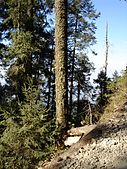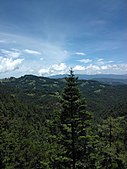- Detail of leaves and immature cones
- Chincua sanctuary, the Monarch Butterfly Biosphere Reserve
- El Rosario sanctuary, the Monarch Butterfly Biosphere Reserve
- In the Sierra Norte, Oaxaca
- Firs and zacatonal on the trail of La Malinche, Tlaxcala
bio.wikisort.org - Plant
Abies religiosa, the oyamel fir or sacred fir,[4] (known as oyamel in Spanish) is a fir native to the mountains of central and southern Mexico (Trans-Mexican Volcanic Belt, Sierra Madre del Sur) and western Guatemala. It grows at high altitudes of 2,100–4,100 metres (6,900–13,500 ft) in cloud forests with cool, humid summers and dry winters in most of its habitat regime. In the state of Veracruz, it grows with precipitation all year long. The tree is resistant to regular winter snowfalls.
| Abies religiosa | |
|---|---|
 | |
| Sacred fir forest at El Chico National Park in Hidalgo, Mexico | |
Conservation status | |
| Scientific classification | |
| Kingdom: | Plantae |
| Clade: | Tracheophytes |
| (unranked): | Gymnosperms |
| Division: | Pinophyta |
| Class: | Pinopsida |
| Order: | Pinales |
| Family: | Pinaceae |
| Genus: | Abies |
| Species: | A. religiosa |
| Binomial name | |
| Abies religiosa | |
| Synonyms[3] | |
| |
Names
The Spanish name oyamel comes from the Nahuatl word oyametl (oya, "to thresh"; metl, "agave"; literally "threshing agave"). It is also called árbol de Navidad (Christmas tree) in Mexico. The English name derives from the binomial Abies religiosa, literally "religious fir". This comes from the use of its cut foliage in religious festivals (notably at Christmas) and in churches in Mexico.[5]
Description
Abies religiosa is a medium-sized to large evergreen coniferous tree growing to 25–50 m (82–164 ft) tall with a trunk diameter of up to 2 metres (6.6 ft). The leaves are needle-like, flattened, 1.5–3.5 cm (0.59–1.38 in) long and 1.5 mm (0.059 in) wide by 0.5 mm (0.020 in) thick, dark green above, and with two blue-white bands of stomata below; the leaf apex is acute. The leaf arrangement is spiral on the shoot, but with each leaf variably twisted at the base so they lie flat to either side of and above the shoot, with none below the shoot. The shoots are reddish-brown, hairless or with scattered pubescence.
The cones are 8–16 cm (3.1–6.3 in) long and 4–6 cm (1.6–2.4 in) broad, dark blue-purple before maturity; the scale bracts are purple or greenish, of moderate length, with the tips exposed in the closed cone. The winged seeds are released when the cones disintegrate at maturity about 7–9 months after pollination. Trees from the western end of the range on Nevado de Colima, Jalisco have cones with larger, reflexed bract scales (similar to noble fir cones); these are sometimes treated as a separate species, Abies colimensis.
Significance
The sacred fir is the preferred tree for the monarch butterfly (Danaus plexippus) to reside in colonies during its hibernation in the forests of the Trans-Mexican Volcanic Belt. Although monarch butterflies are known in other parts of the southern Mexican highlands as some specimens do not migrate, the bulk of them gather in a few protected fir forests in the Monarch Butterfly Biosphere Reserve near the towns of Angangueo (Michoacán) and Avándaro (State of Mexico), from December to March.
The wood of the sacred fir is rather soft and thus not very suited for woodworking. Nonetheless, its distribution is decreasing because of logging for fuel and other human-related disturbances.[6]
A 2012 paper by Cuauhtemoc Saenz-Romero among others, published in Forest Ecology and Management found that "the area suitable for the oyamel is likely to diminish by 96 percent by 2090, and disappear completely within the [Monarch Butterfly Biosphere] reserve."[7][8]
Gallery
References
- Farjon, A. (2013). "Abies religiosa". IUCN Red List of Threatened Species. 2013: e.T39592A2929657. doi:10.2305/IUCN.UK.2013-1.RLTS.T39592A2929657.en. Retrieved 19 November 2021.
- "Abies religiosa". Germplasm Resources Information Network (GRIN). Agricultural Research Service (ARS), United States Department of Agriculture (USDA). Retrieved 2009-10-22.
- The Plant List
- "Abies religiosa" at the Encyclopedia of Life
- Timbers of the New World. Arno Press. 1943. p. 13. ISBN 9780405028069.
The specific epithet (religiosa) refers to the common use of the evergreen branches for decorations in churches.
- "Oyamel (Abies religiosa)" (PDF). CONABIO. Retrieved 2016-08-30.[permanent dead link]
- Linthicum, Kate (April 13, 2019). "Mexican scientists move forest to save butterflies". Los Angeles Times. Retrieved January 5, 2020.
- René I. Alfaroa; Bruno Fady; Giovanni Giuseppe Vendramin; Ian K. Dawson; Richard A. Fleming; Cuauhtémoc Sáenz-Romero; Roberto A. Lindig-Cisneros; Trevor Murdock; Barbara Vinceti; Carlos Manuel Navarro; Tore Skrøppa; Giulia Baldinelli; Yousry A. El-Kassaby; Judy Loo (1 December 2014). "The role of forest genetic resources in responding to biotic and abiotic factors in the context of anthropogenic climate change". Forest Ecology and Management. 333: 76–87. doi:10.1016/j.foreco.2014.04.006.
- Liu, T. S. (11 November 1971). A Monograph of the genus Abies. National Taiwan University.
На других языках
[de] Heilige Tanne
Die Heilige Tanne (Abies religiosa) ist eine Pflanzenart aus der Gattung der Tannen (Abies). Sie kommt von Mexiko bis ins westliche Guatemala vor.- [en] Abies religiosa
[es] Abies religiosa
El oyamel (Abies religiosa) es una conífera de la familia de las pináceas. Es un abeto nativo de las montañas centrales y del sur de México (Eje Neovolcánico, Sierra Madre del Sur) y del oeste de Guatemala. Crece hasta 60 m de altura. Sus hojas son aciculares y sus ramas tienen forma de cruz y de ahí su nombre "religiosa". Crece a altitudes de 2500 a 4100 m s. n. m. en bosques frescos y con alta precipitación, de veranos húmedos y caída de nieve invernal. Es el árbol preferido de la mariposa Monarca en los sitios de hibernación de Michoacán y Estado de México.[ru] Пихта священная
Пихта священная, или Пихта мексиканская[3] (лат. Abies religiosa) — дерево, вид рода пихта (Abies) семейства Сосновые (Pinaceae). Произрастает в горах центральной и южной Мексики (на Поперечной Вулканической Сьерре и Южной Сьерра-Мадре) и в западной Гватемале.Другой контент может иметь иную лицензию. Перед использованием материалов сайта WikiSort.org внимательно изучите правила лицензирования конкретных элементов наполнения сайта.
WikiSort.org - проект по пересортировке и дополнению контента Википедии





